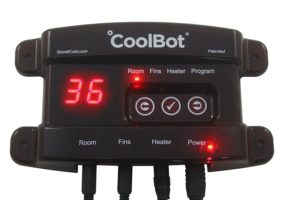
Refrigeration is unaffordable for many farmers in developing nations, leading to the majority of produce spoiling before it can be used. Students on the Solar-Powered Refrigeration Team are using their mechanical engineering Senior Design project to test solutions that could one day make refrigeration affordable and sustainable for farmers.
The life of a harvest is prolonged using refrigeration, with less waste and better opportunities to sell crops. Commercial refrigeration, however, is prohibitively expensive, particularly in developing countries. A technology called CoolBot can modify a standard home air conditioning unit to keep produce cooler, and may prove to be a more affordable and sustainable solution.
“You take a stock room air conditioner, attach the CoolBot unit to it, and it takes the temperature that the air conditioner can normally maintain, about 75 degrees, down to about 40 degrees,” said Jerry Duggan, advisor for the project.
Produce stays fresher longer at an average of 40 degrees, and using the CoolBot technique saves energy, material costs, and servicing concerns. Store It Cold, the company that created the CoolBot technology, donated a unit to the team as part of an ongoing effort to work with other organizations on problems in the developing world.
Costing hundreds of dollars rather than thousands, CoolBot could provide an inexpensive alternative to commercial refrigeration units, putting the cost within reach for poorer nations. Leveraging software modeling with data gathered from a physical model, the team is working to validate whether the unit would perform well in different scenarios.

Software models and real-world testing
The software can create scenarios with varying wind patterns, solar panel layout and angles, and the variance of temperature crucial to keeping food fresh for longer periods of time. These virtual models can then be used in combination with real-world data to find the most efficient cooling system, and eventually to identify efficiencies through current and voltage testing.
Real-world data is being collected from northern Colorado’s environment via the physical model, currently placed outdoors at the Methane Emissions Test and Evaluation Center (METEC) on the Colorado State University Foothills Campus. The model, a 6 foot cube, is set up with a CoolBot, a standard air conditioner, and numerous sensors for airflow, temperature, and solar data. Once the base data is gathered, it is added into the software model for testing.
“We form the base model as best we can with our Colorado environment, since those are all our known conditions,” said Eric Schulte, the team’s student project manager. “We then should be able to take the solar data from a different place, like Rwanda, and put that into the software.”
Senior Design experience pays off
Experience and coursework were essential for the entire team to build the physical model, especially during their build week. Courses in manufacturing processes and design drawings were particularly important, as four different people worked on the model simultaneously. Schulte added that without good drawings and solid concepts, the team would not have been able to build the model properly.
The project not only gave the students experience working as a team, it was an opportunity to make a difference. “On the short scale of a Senior Design project,” said Schulte, “there are still real problems that you can take some decent steps on. You can definitely have an impact as a student, and if you find something that interests you there’s probably something tangible that you can actually do.”